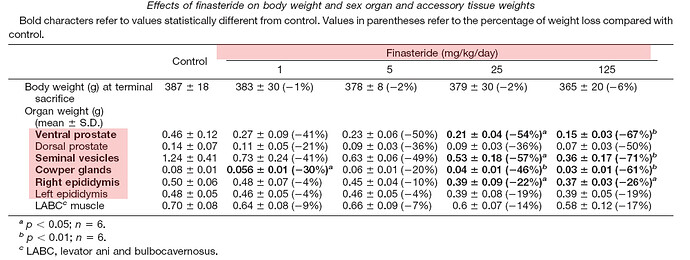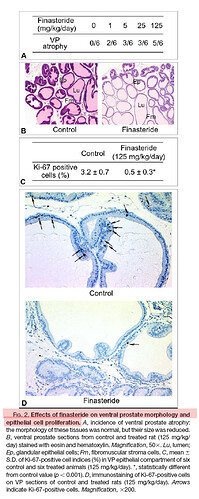Another study:
Long-term effects of Fin on Prostate tissue composition
PDF: usrf.org/news/070703_finaste … f6D1E3.pdf
INCLUDES COLOR PHOTOMICROGRAPHS SHOWING FINASTERIDE’S EFFECTS ON PROSTATE TISSUE.
Objectives. To determine the long-term effects of finasteride treatment on prostate tissue composition; to relate these effects to clinical outcomes; and to test the hypothesis that finasteride exerts a selective or preferential action on the transition zone.
Methods. Nineteen men with symptomatic benign prostatic hyperplasia (BPH) who completed a 6-month double-blind trial of finasteride were enrolled in a 24-month open-label extension study of drug responders. Magnetic resonance imaging and prostate biopsy for morphometric analysis were performed together 70 times: at baseline (n 5 19), after treatment periods of intermediate duration (6 to 18 months, n 5 32), and after long-term drug treatment (24 to 30 months, n 5 19). At baseline, prostate volume averaged 51 cc, of which 57% was transition zone.
Results. Decreases in symptom score, dihydrotestosterone and prostate-specific antigen levels, and prostate volume occurred at 6 months (P ,0.01), stabilized, and were maintained without further long-term decreases. Prostate epithelium contracted progressively from baseline (19.2% tissue composition; 6.0-cc volume; 3.2 stroma/epithelial ratio) to intermediate (12.5%, 3.3 cc, and 5.6, respectively) to long-term treatment (6.4%, 2.0 cc, and 17.4, respectively, P ,0.01 for all). Percent epithelial contraction was similar in the peripheral and transition zones (P 5 NS). The transition zone remained a relatively constant proportion (53% to 58%) of whole-prostate volume from baseline to long-term observation.
Conclusions. Long-term finasteride treatment (24 to 30 months) results in a marked involution of the prostate epithelium, which continues to progress for many months after clinical effects stabilize. The effect on the epithelium is similar in the peripheral and transition zones for both morphometric and volumetric changes. Progressive contraction of the prostate epithelium appears to constitute the underlying mechanism for sustained action of finasteride.
Longterm effects of Finasteride on prostate tissue.pdf (528 KB)


